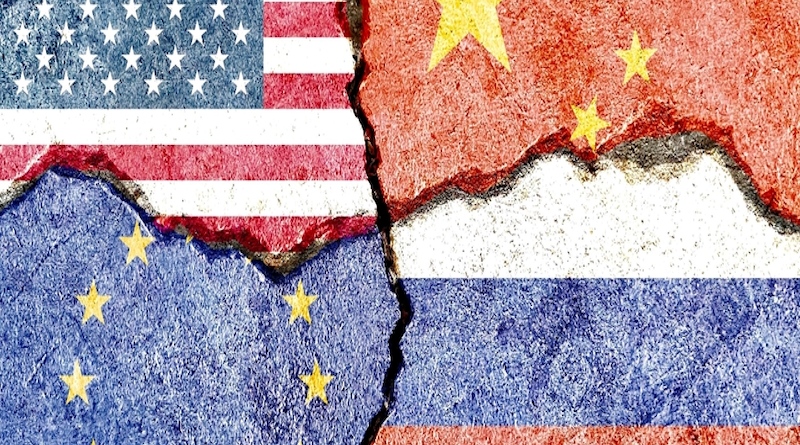Navigating Conflict And Diplomacy: The Complex Relations Between The USA, EU, NATO, And Russia – OpEd
The relationships among the United States, European Union, NATO, and Russia in 2024 exemplify the complexities inherent in a shifting global order, shaped by competing geopolitical ambitions, security concerns, and economic challenges. While there exist opportunities for diplomatic engagement, a pervasive atmosphere of mistrust and conflict poses significant risks to future cooperation, underscoring the necessity for recalibrated strategies to avert further escalation.
Historically, interactions among these entities reflect a trajectory that commenced with initial optimism but has devolved into entrenched scepticism. Following the Cold War, the early 1990s witnessed tentative cooperation, epitomised by the NATO-Russia Founding Act of 1997, which aimed to cultivate collaborative relations. However, NATO’s eastward expansion, which incorporated former Soviet states, has exacerbated Russian apprehensions and undermined trust. This decline was starkly illustrated by Russia’s annexation of Crimea in 2014, prompting Western nations to impose stringent sanctions.
The approach of the United States towards Russia has varied significantly across different administrations. President Obama emphasised a “reset” strategy, President Trump preferred a transactional framework, and President Biden has adopted a confrontational stance, prioritising human rights and democratic principles.
The European Union has similarly navigated substantial challenges in its relationship with Russia. The bloc’s economic dependence on Russian energy resources complicates its political posture, resulting in a precarious equilibrium between economic ties and political integrity. As of 2024, the ongoing conflict in Ukraine continues to place considerable strain on the EU, leading member states to seek alternative energy sources while reassessing their security strategies. Moreover, tensions within the EU are further complicated by divergent interests, particularly between Eastern European nations, which are wary of Russian aggression, and Western nations such as Germany and France, which advocate for diplomatic engagement.
NATO’s evolution has mirrored these tensions, as the alliance increasingly positions itself as a counterweight to Russian assertiveness. The deployment of NATO forces in Eastern Europe, particularly in response to the Ukraine crisis, has intensified security concerns and resulted in a militarised standoff. The prior dialogue that characterised NATO-Russia relations has largely dissipated, giving way to military posturing and a cycle of provocations.
Furthermore, the emergence of cyber warfare and disinformation campaigns introduces additional complexity, compelling both NATO and Russia to confront novel forms of conflict that transcend traditional military boundaries. Several critical issues underscore the challenges in relations among the USA, EU, NATO, and Russia as of 2024. The ongoing conflict in Ukraine remains a focal point, with Russia’s military operations eliciting condemnation and sanctions from Western nations. This situation exacerbates humanitarian crises and contributes to broader instability in Europe. The potential for escalation is high, particularly given the interplay of nuclear rhetoric and military exercises from both sides. Furthermore, sanctions imposed on the Russian economy have fostered increased cooperation with non-Western powers, notably China, thereby creating a new geopolitical axis that undermines Western influence.
Energy dependency represents another pressing issue, particularly for Europe. The energy crisis, exacerbated by the war in Ukraine, has catalysed the EU’s vigorous pursuit of alternatives to Russian oil and gas. This shift aims not only to enhance energy security but also to diminish Russia’s leverage over European economies. The transition towards renewable energy, along with investments in liquefied natural gas (LNG) infrastructure, signifies a significant pivot in EU energy policy. Nevertheless, this transition faces considerable challenges, including rising energy prices and the necessity for collective action among member states.
Looking ahead, there are potential avenues for renewed de-escalation and diplomacy, although these prospects are framed by a backdrop of uncertainty. One possibility involves reviving peace negotiations in Ukraine, potentially facilitated by neutral parties seeking to mediate an end to hostilities, with countries such as Turkey and China playing pivotal roles. Additionally, there may be scope for arms control agreements, which have historically provided frameworks for managing nuclear arsenals and reducing conflict risks. However, establishing such agreements would necessitate substantial trust-building measures, a formidable challenge given the current state of relations.
Energy realignment in Europe may also present a pathway forward. By investing in diversified energy sources and enhancing cooperation with allies, the EU can reduce its vulnerability and mitigate Russian leverage. Ultimately, this shift could pave the way for discussions concerning shared security concerns. Furthermore, NATO’s evolution may offer opportunities for recalibrating relations if the alliance can balance deterrence with diplomatic engagement, thereby ensuring that military readiness does not undermine dialogue.
In conclusion, the dynamics among the European Union, the United States, NATO, and Russia in 2024 are characterised by significant challenges arising from the ongoing conflict in Ukraine, energy dependencies, and mutual distrust. While there are opportunities for diplomatic solutions—particularly through renewed dialogue and energy diversification—the prevailing tensions necessitate a careful strategic approach to mitigate the risk of further escalation. Future cooperation will hinge on the capacity of these actors to navigate complex geopolitical landscapes, balance national interests with collective security, and foster an environment conducive to rebuilding trust. Although the path ahead is likely to present numerous obstacles, the pursuit of a more stable and cooperative international order remains a crucial objective.
The opinions expressed in this article are the author’s own.
References
- Pomerantsev, P., & Weiss, M. (2014). The Menace of Unreality: How the Kremlin Weaponizes Information, Culture and Money. The Institute of Modern Russia.
- Smith, H. (2023). The Politics of Energy in the European Union: Between Dependence and Autonomy. Journal of European Integration.
- Sweeney, M. (2023). The Ukraine War: Impact on European Security and NATO. Global Affairs Journal.

